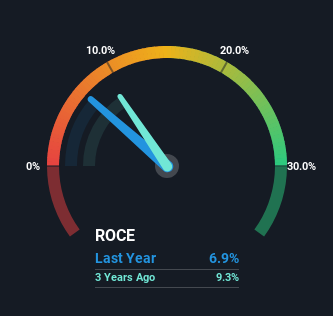- China
- /
- Semiconductors
- /
- SHSE:688223
Here's What's Concerning About Jinko Solar's (SHSE:688223) Returns On Capital

What trends should we look for it we want to identify stocks that can multiply in value over the long term? Amongst other things, we'll want to see two things; firstly, a growing return on capital employed (ROCE) and secondly, an expansion in the company's amount of capital employed. Ultimately, this demonstrates that it's a business that is reinvesting profits at increasing rates of return. In light of that, when we looked at Jinko Solar (SHSE:688223) and its ROCE trend, we weren't exactly thrilled.
Return On Capital Employed (ROCE): What Is It?
Just to clarify if you're unsure, ROCE is a metric for evaluating how much pre-tax income (in percentage terms) a company earns on the capital invested in its business. Analysts use this formula to calculate it for Jinko Solar:
Return on Capital Employed = Earnings Before Interest and Tax (EBIT) ÷ (Total Assets - Current Liabilities)
0.069 = CN¥4.4b ÷ (CN¥125b - CN¥61b) (Based on the trailing twelve months to June 2024).
So, Jinko Solar has an ROCE of 6.9%. On its own that's a low return, but compared to the average of 4.3% generated by the Semiconductor industry, it's much better.
Check out our latest analysis for Jinko Solar

In the above chart we have measured Jinko Solar's prior ROCE against its prior performance, but the future is arguably more important. If you're interested, you can view the analysts predictions in our free analyst report for Jinko Solar .
So How Is Jinko Solar's ROCE Trending?
The trend of ROCE doesn't look fantastic because it's fallen from 9.2% five years ago, while the business's capital employed increased by 419%. That being said, Jinko Solar raised some capital prior to their latest results being released, so that could partly explain the increase in capital employed. Jinko Solar probably hasn't received a full year of earnings yet from the new funds it raised, so these figures should be taken with a grain of salt.
On a side note, Jinko Solar has done well to pay down its current liabilities to 49% of total assets. That could partly explain why the ROCE has dropped. Effectively this means their suppliers or short-term creditors are funding less of the business, which reduces some elements of risk. Some would claim this reduces the business' efficiency at generating ROCE since it is now funding more of the operations with its own money. Either way, they're still at a pretty high level, so we'd like to see them fall further if possible.
What We Can Learn From Jinko Solar's ROCE
Bringing it all together, while we're somewhat encouraged by Jinko Solar's reinvestment in its own business, we're aware that returns are shrinking. And in the last year, the stock has given away 25% so the market doesn't look too hopeful on these trends strengthening any time soon. Therefore based on the analysis done in this article, we don't think Jinko Solar has the makings of a multi-bagger.
On a separate note, we've found 2 warning signs for Jinko Solar you'll probably want to know about.
For those who like to invest in solid companies, check out this free list of companies with solid balance sheets and high returns on equity.
If you're looking to trade Jinko Solar, open an account with the lowest-cost platform trusted by professionals, Interactive Brokers.
With clients in over 200 countries and territories, and access to 160 markets, IBKR lets you trade stocks, options, futures, forex, bonds and funds from a single integrated account.
Enjoy no hidden fees, no account minimums, and FX conversion rates as low as 0.03%, far better than what most brokers offer.
Sponsored ContentNew: Manage All Your Stock Portfolios in One Place
We've created the ultimate portfolio companion for stock investors, and it's free.
• Connect an unlimited number of Portfolios and see your total in one currency
• Be alerted to new Warning Signs or Risks via email or mobile
• Track the Fair Value of your stocks
Have feedback on this article? Concerned about the content? Get in touch with us directly. Alternatively, email editorial-team (at) simplywallst.com.
This article by Simply Wall St is general in nature. We provide commentary based on historical data and analyst forecasts only using an unbiased methodology and our articles are not intended to be financial advice. It does not constitute a recommendation to buy or sell any stock, and does not take account of your objectives, or your financial situation. We aim to bring you long-term focused analysis driven by fundamental data. Note that our analysis may not factor in the latest price-sensitive company announcements or qualitative material. Simply Wall St has no position in any stocks mentioned.
About SHSE:688223
Jinko Solar
Engages in the design, development, production, and marketing of photovoltaic products and integrated clean energy solutions worldwide.
Fair value with moderate growth potential.
Market Insights
Community Narratives




